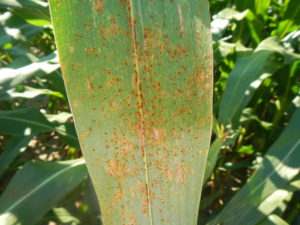Southern rust of corn is normally a disease of tropical areas. During summer months, however, the fungus which causes southern rust, Puccinia polysora, often moves into southern areas of the U.S. This summer, southern rust has been observed in at least 11 Indiana counties.
Symptoms of southern rust include raised structures called pustules. If rubbed with a finger, the spores in rust pustules will come off leaving a stain on one’s hand. Southern rust develops rust pustules primarily on the upper leaf surface (Figure 1). Common rust typically has rust pustules on both upper and lower leaf surfaces. In severe cases, southern blight can cause rust pustules on ear husks and leaf sheaths. Late in the summer, dark pustules may be formed which are called telia. It is possible to confuse southern rust with other diseases, therefore, a confirmation by the Purdue University Plant and Pest Laboratory is advised.

Figure 1. Southern blight causes red-orange pustules primarily on the upper surface of sweet corn. (Photo by Kiersten Wise)
The fungus that causes southern rust requires a living host plant to survive. Thus, the fungus does not overwinter in Indiana and instead must be blown into the state. When conditions favor rust development, the disease may become severe in a short period. A new rust pustule can develop from an infection in just 9 days and each rust pustule can produce rust spores for about 8 days.
Infection by the southern rust fungus can take place after about 6 hours of leaf wetness. Therefore, dew can often provide sufficient leaf wetness. Southern rust is favored by high relative humidity and temperatures around 80°F.
Young leaves are more susceptible than mature leaves, so the development stage at the onset of southern rust will affect disease development. Other factors affecting disease severity are the susceptibility of the hybrid and the length of time weather conditions favor disease development.
Southern rust can cause yield loss since the causal fungus competes with the plant for nutrients. Rust pustules also rupture the leafs surface which may cause water loss. In severe cases, yield losses of up to 45% have been recorded.
While a few field corn hybrids possess resistance genes to southern rust, sweet corn hybrids are almost universally susceptible. Foliar fungicides can be effective at slowing the progress of southern rust. For field corn, fungicide applications when southern rust is detected after the milk stage are seldom economically beneficial. Therefore, late planted sweet corn is more likely to require fungicide applications.
Fungicide information for sweet corn may be found in the Midwest Vegetable Production Guide for Commercial Growers (ID-56) mwveguide.org. Recommended products for rust on sweet corn includes: Headline 2.09 EC/SC®, Quilt Xcel 2.2SE® and Priaxor 4.17SC®. Always consult the label before each fungicide application.
Most sweet corn production is well enough along that, in my opinion, fungicides will not be required for southern blight management. However, it makes sense to scout fields for southern rust as well as other diseases.
Much of the information in this article came from the following publication from the Crop Protection Network: Southern Rust, CPN-2009 http://cropprotectionnetwork.org/corn/southern-rust-cpn-2009/. The progress of southern rust may be followed at the following website: http://ext.ipipe.org/ipipePublic/index.php#post=22.